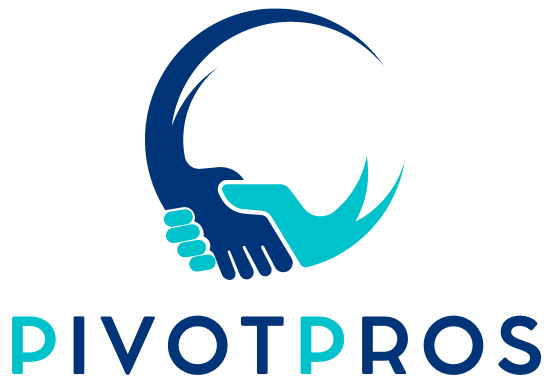Did you know that in 2023 alone, 5.48 million businesses applied for registration in the U.S.? That’s according to the U.S. Census Bureau.
Now, imagine the challenge of coming up with a unique business name that stands out among millions each year.
It’s no surprise that finding a name that’s not only memorable and relevant to your brand but also available can feel overwhelming.
But here’s the thing: it doesn’t have to be.
While it may seem like everything good is taken, the right strategy can help you create a name that captures your brand’s essence, resonates with your audience, and is still available.
In this article, we’ll guide you through practical steps to help you come up with a business name that works—without getting stuck in overthinking mode.
I’ll also give you a framework and a bunch of fill-in-the-blank templates you can use to quickly find the name for your dream business.
Let’s get started!

Why Coming Up With the Right Business Name Is Important
Your business name isn’t just a label—it’s your first shot at making an impression that sticks. It’s the difference between someone instantly connecting with your brand or scrolling right past it.
Let’s break down why this step matters so much.
It Paints a Picture
The right business name creates an instant image in the mind of your audience.
Think of Pinterest.
From the moment you hear it, you can almost see the concept—it’s about pinning your interests.
A well-chosen name can spark curiosity and instantly explain what your business is about, saving you from lengthy introductions.
Whether you’re selling products or services, a name that visually or emotionally connects to your business’s purpose can make you more relatable and memorable.
It Shows Your Brand’s Personality
Your name is one of the earliest indicators of what kind of vibe your business gives off.
Is it fun and quirky, like Innocent Drinks? Or is it sophisticated and luxurious, like Chanel?
The name should match the personality of your brand because that’s what customers will feel right from the start.
For example, Slack suggests simplicity and ease of use—exactly what you want from a tool that makes workplace communication easier.
It Targets Your Audience
A business name should speak directly to the people you want to attract. Consider Teen Vogue—it’s clear from the name that their content and products are tailored to a younger, fashion-forward audience.
On the other hand, Harvard Business Review tells you it’s targeting professionals and academics.
A well-crafted name gives your target audience a reason to feel connected to your brand because it shows you understand their world.
By choosing words that resonate with your ideal customer, you increase your chances of grabbing their attention and making them feel like your brand is for them.
It Sets the Tone for Your Brand’s Identity
Your name is the starting point for building your brand identity.
A name like Nike or Apple doesn’t just sound good; it sets a tone that the company builds on with its design, marketing, and customer experience.
When you pick the right name, it sets the foundation for everything else, including your logo, slogan, and brand voice.
Your entire branding can grow naturally from that name, making it easier for customers to recognize and trust you.
In short, your business name has the power to communicate who you are, what you do, and who you do it for—all within a few words.
It’s the key to making your business more approachable, relatable, and memorable from the very start.
12 Tips for Choosing the Perfect Business Name
Now that you understand why your business name is so important, let’s dive into how to actually come up with one. This part is where creativity meets strategy.
The right name doesn’t just pop up out of nowhere—it requires a mix of brainstorming, research, and fine-tuning.
But don’t worry, it’s not as overwhelming as it sounds.
Below are 11 practical tips that will guide you through the process of finding a name that reflects your brand, resonates with your audience, and sets you up for success.
Ready to get started? Let’s jump in!

1. Start With Clarity
Your business name should be easy to understand right off the bat.
If people have to scratch their heads or ask what your business does, the name isn’t doing its job.
A clear and straightforward name ensures that anyone who sees it immediately gets a sense of what your business is about, or at the very least, isn’t confused by it.
How to do it:
- Stick to familiar words: Avoid using overly complex or obscure words. Think of well-known brands like Facebook and PayPal—they’re straightforward and immediately give you a sense of what the platform is for.
- Make it descriptive (but not limiting): Try to incorporate hints of what your business does without boxing yourself into a corner. For example, Dropbox clearly suggests a place where you can store things, without limiting the company to a specific type of file or service.
- Avoid jargon or niche language: Unless your audience is highly specialized, keep industry jargon out of your business name. You want a name that’s accessible to everyone, not just a select few.
2. Think About Your Audience
Your business name should resonate with your target audience. It’s not just about what sounds cool to you—it’s about what clicks with the people you want to attract.
A name that aligns with your audience’s values, interests, or lifestyle makes it easier for them to connect with your brand.
How to do it:
- Understand your customers: Think about who your ideal customer is. Are they young and trendy or more conservative and professional? A name like Urban Outfitters speaks directly to a younger, city-dwelling audience, while The Wall Street Journal appeals to business professionals.

- Match the tone: The tone of your name should match the experience you want to offer. For example, a playful brand like Fatburger uses a fun, informal name that reflects its casual dining experience. On the other hand, a name like Goldman Sachs conveys a more serious, high-end tone.
- Consider cultural relevance: Make sure your name resonates across different cultures if you plan to go global. A name that makes sense in one language may not translate well to another. A simple check can prevent awkward or confusing interpretations in different markets.
3. Keep It Short and Sweet
The best business names are often the simplest. Long or complicated names can be hard to remember, difficult to spell, and tricky to use in a logo or domain.
A short, punchy name sticks in people’s minds and is easier to share, whether it’s through word of mouth or social media.
How to do it:
- Limit to one or two words: Short names like Nike, Google, or Uber work because they’re easy to say and remember. Keep your name as concise as possible, avoiding the temptation to describe everything your business does in one long string of words.
- Avoid unnecessary complexity: Don’t overcomplicate things with strange spellings or symbols. A name like Flickr works because it’s short, but if it were harder to spell, it could confuse people and be difficult to search for.
- Test for ease of use: Say the name out loud a few times. Does it roll off the tongue? Can others repeat it easily after hearing it once? If the name feels clunky or hard to pronounce, simplify it.
4. Make Sure It’s Easy to Spell and Pronounce
If people can’t spell or pronounce your business name easily, they’ll have a hard time finding you online or talking about your brand.
The last thing you want is to lose potential customers because they’re confused about how to search for your business or recommend it to others.
How to do it:
- Stick to common spellings: Avoid unusual spellings that might trip people up. For example, names like Lyft and Flickr work because their target audience is younger and familiar with tech trends, but for most businesses, you’re better off sticking with traditional spellings.
- Say it out loud: A name should sound just as good spoken as it looks in writing. Say it out loud and ask others to do the same. Can they pronounce it easily without stumbling?
- Avoid homophones: Steer clear of names that sound like other words, which could lead to confusion. For instance, a name like Sole might work for a shoe brand, but it could easily be mixed up with “soul” or “sole” in other contexts.
5. Check for Domain Availability
In today’s digital world, your online presence is just as important as your physical one.
Before you fall in love with a business name, make sure the domain is available.
Your website is often where potential customers will go to learn more about your business, so having a domain that matches your business name is key.
How to do it:
- Search domain registrars: Use tools like GoDaddy, Namecheap, or Google Domains to check if your business name is available as a .com domain (or another relevant extension like .net, .shop, etc.). For example, if you like the name GreenLeaf, but the .com domain is taken, you might need to reconsider or modify your choice.
- Consider alternatives: If the exact domain isn’t available, don’t panic. You can add a small tweak, like your location or industry (GreenLeafBakery.com or GreenLeafNYC.com) to create a unique but related domain name.
- Avoid confusing extensions: While you can get creative with extensions like .co or .info, sticking with a .com is generally best for most businesses since it’s the most recognizable and trusted by customers.
6. Make It Future-Proof
Your business may evolve, and you don’t want to be stuck with a name that limits your potential for growth.
A future-proof business name ensures that as your business expands or pivots, your name can still represent it without sounding outdated or restrictive.
How to do it:
- Avoid specifics: Stay away from names that box you into a particular product, service, or location. For example, a name like Boston Laptop Repair may work if you only plan to stay in Boston and focus on laptop repairs, but if you expand to other regions or offer more services, the name could limit you.
- Think about future products: If there’s any chance you might expand your product line or services, pick a name that allows for that. For instance, Amazon started as a bookstore but was able to grow into a global retail giant without changing its name.
- Be broad but clear: Choose something broad enough to encompass future changes, but still relevant to what you currently do. Apple is a great example of this—while it doesn’t directly describe their products, it’s flexible enough to cover everything from computers to phones and more.
7. Test It Out on Real People
It’s easy to fall in love with a name, but it’s important to see how others react to it.
What sounds good to you might not resonate with your audience or be as clear as you think.
Testing your business name on a group of people can provide valuable insights and help you avoid potential pitfalls.
How to do it:
- Get feedback from your target audience: Share your top name choices with people who fit your target demographic. This will give you an idea of how well the name connects with the people you’re trying to attract.
- Use surveys or polls: Tools like Google Forms or SurveyMonkey can help you gather opinions from a wider audience. You can also use social media platforms like Instagram or Twitter to create polls and gauge reactions.
- Listen to honest feedback: Be open to criticism. If people have trouble pronouncing, spelling, or understanding the name, it’s better to know now than after you’ve launched your business. Don’t be afraid to go back to the drawing board if needed.
8. Make It Easy to Brand
Your business name should not only sound good but also look good across all branding materials.
Whether it’s on a website, a business card, or a social media profile, your name should be easy to incorporate into your overall brand design and marketing strategy.
How to do it:
- Visualize the name in a logo: Try pairing the name with potential logo designs. Does it fit well in different formats? Can it be styled in a way that looks appealing across different mediums like a website, signage, or promotional materials? For instance, names like Google or Coca-Cola are easily recognizable in both their logos and written form.
- Consider font and style: Choose a name that lends itself to a clean, readable font style. Some names look great in print, while others might feel clunky or hard to style. For example, the brand Netflix uses a simple, bold font that matches its straightforward and user-friendly image.
- Ensure social media compatibility: Your name should work seamlessly across social media platforms. This includes being short enough for Twitter handles and easily searchable on platforms like Instagram or Facebook.
9. Check for Legal Issues
The last thing you want after falling in love with a business name is to find out it’s already trademarked or in use by another company.
Before you move forward with any name, make sure it’s legally available to avoid expensive legal battles or rebranding down the road.
How to do it:
- Search for trademarks: Use tools like the United States Patent and Trademark Office (USPTO) database or WIPO’s global trademark search to see if the name you want is already registered. If it’s already taken, you’ll need to brainstorm new options or risk legal trouble.
- Check business name databases: If you’re registering an LLC or corporation, check your Secretary of State’s website to make sure no one else in your state is using the same name. Even if it’s available as a domain, it might still be legally off-limits as a business name.
- Consult a lawyer if needed: If you’re uncertain, it can be worth consulting with a lawyer who specializes in business trademarks to ensure your name is fully protected and available.
10. Make Sure It’s Unique
In a crowded marketplace, standing out is key. Your business name should be distinct enough to differentiate you from competitors, while still being relevant to your industry.
A unique name helps you carve out your own space and avoid confusion with other brands.
How to do it:
- Research your competition: Look up similar businesses in your industry and take note of their names. Aim for a name that sets you apart rather than blending in. For example, if you’re starting a tech company, you wouldn’t want to name it something too close to Microsoft or Apple.
- Avoid clichés: Stay away from overused words or phrases in your industry. For example, in the fitness industry, names with words like “fit” or “strong” are common. Try to think outside the box and create something more original.
- Google it: A quick Google search can reveal if there are other businesses with similar names or if your name has any negative connotations that you hadn’t considered.
11. Trust Your Instincts
At the end of the day, you know your business better than anyone else. While all the research and feedback are crucial, sometimes the best way to finalize a name is to trust your gut.
If a name feels right to you, it probably reflects the essence of your business.
How to do it:
- Tune out the noise: Once you’ve gone through all the steps—brainstorming, testing, and checking availability—trust your own judgment. If a name resonates with you and aligns with your vision, it’s likely to resonate with others as well.
- Give it time: Sometimes, sitting with a name for a few days can help you decide if it’s truly the one. If you still feel excited about it after some time has passed, you’re probably on the right track.
- Be confident: Every great business name once started as just an idea. Whether it’s as iconic as Nike or as simple as Amazon, your name will grow with your business, and you’ll make it your own through your brand and the story you build around it.
12. Avoid Words with Negative Associations
One crucial step in choosing a business name is ensuring it doesn’t carry any unintended negative connotations.
A name that seems innocent or clever to you might be associated with something inappropriate or controversial in another language, culture, or even in the media.
It’s easy to overlook this step, but ignoring it can lead to PR nightmares or missed opportunities with potential customers.
How to do it:
- Google the name: Conduct a thorough search to see if the name is tied to any negative news, controversies, or undesirable slang. This will help you avoid names that could unintentionally link your brand to something negative.
- Check for cultural and language sensitivity: If you plan to expand internationally or cater to different cultures, research your name in various languages. A classic example is Chevy Nova, where “Nova” in Spanish means “doesn’t go,” which impacted the brand’s perception in Spanish-speaking markets.
- Look for trending or slang terms: Check current slang and trends, as a name that seems harmless now could evolve into something problematic. What’s considered “cool” today might have negative implications in a few years.
A Simple Framework for Naming Your Business
If you’re still stuck on what to name your business, don’t worry—having a framework can help narrow down your options. Sometimes, filling in the blanks with key elements of your brand can spark inspiration.
Below is a simple, fill-in-the-blank template to guide you through creating a business name that reflects your brand and resonates with your audience.
Business Name Template + Examples
[Adjective] + [Noun]
- Example: Blue Apron (combining a color with a kitchen item).
- How to use it: Think of a descriptive word that reflects your business’s personality (fun, serious, vibrant) and pair it with a relevant noun that ties into your product or service.
[Verb] + [Noun]
- Example: Dropbox (describing an action and a place).
- How to use it: Consider an action that describes what your customers will do with your product or service, then match it with a noun that gives clarity about what your business offers.
[Location] + [Keyword]
- Example: New York Bagels (combining a place with a product).
- How to use it: If your business is location-based or tied to a specific region, consider using the location in your name. Be careful with this if you plan to expand beyond that area later on.
[Target Audience] + [Noun]
- Example: Teen Vogue (specifying the target market and the product).
- How to use it: Identify your target audience (kids, teens, professionals) and pair it with a relevant noun that describes what you offer.
[Made-up Word] + [Descriptive Word]
- Example: Google (a playful, made-up word) or Microsoft (combining “micro” and “software”).
[Metaphor] + [Industry Term]
- Example: Red Bull (a metaphor for energy combined with a visual symbol).
- How to use it: Think of a metaphor that represents what your business stands for and pair it with a term from your industry. This can help create a strong visual or emotional connection with your audience.

Are You Ready To Come Up With The Perfect Business Name?
Choosing the perfect business name doesn’t have to be a daunting process. While it’s important not to overthink it, the right name does set the tone for your brand and helps make a strong first impression.
A great name reflects your business’s identity, speaks to your target audience, and can grow with you as your business evolves.
By following the tips and using the framework outlined in this article, you’ll be well on your way to creating a memorable, meaningful name that represents your brand and sticks with your customers.
Remember, your business name is just the start—what truly defines your success is the quality of your product, your dedication to serving your customers, and the experience you create for them.
